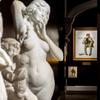America’s Storyteller: Norman Rockwell
- April 02, 2012 07:58
No other artist has been able to capture the essence of the American experience like Norman Rockwell. Even in the early stages of his career, the aspect that distinguished his work was that it was about the Everyman, providing a chronicle of the simple joys, awkward moments and trying circumstances that give our lives depth.
Rockwell found success at an early age. He completed his first commission for a series of Christmas cards before he was 16. By 17, he illustrated his first children's book, and at 22, he had earned his first Saturday Evening Post cover, published May 20, 1916. His work with the Post had skyrocketed his reputation, and before long, the young artist (though he was more confident referring to himself an illustrator rather than an artist) attained the rank of national celebrity. Though many changes occurred over the six decades he painted, the common thread that connects each and every work is the genuine, unmistakable sentimentality that makes Rockwell's art stand out from all others.
Rockwell found inspiration in daily life and the events that touched every individual, regardless of their place in society. In The Common Touch (Stock Exchange Quotations) each person represents the segments of society, all equally touched by the Stock Market Crash of 1929. The wealthy businessman, the elderly woman, the homemaker, the grocer's assistant, and even the dog, all had a steak in the economic downturn that gripped our nation. Rockwell's brilliance shines even though troubled times, as he is able to tackle such a somber reality with heartfelt, yet witty sincerity.
The Buggy Ride, on the other hand, takes a nostalgic look at a moment everyone can identify with-young love. The perspective is that of the viewer, whether a third party or the subjects as adults, looking back upon fond memories of a time long past, but not forgotten. One can even imagine Rockwell reminiscing of such a moment in his own adolescents as he painted the two shy youths enjoying an evening ride and each other's companionship.
Original paintings, like the above, that were created early in Rockwell's career are quite exceptional. In 1943, the artist's studio caught fire, and numerous paintings were destroyed in the blaze. Adding to their rarity is the fact that each served as a Post cover, The Common Touch on January 18, 1930, and The Buggy Ride on September 19, 1925.
Rockwell once stated, "I don't want to paint for the few who can see a canvas in a museum, for I believe that in a democracy art belongs to the people." Rich or poor, young or old, male or female, anyone could personally identify with each painting he composed. Both technically superb and emotionally powerful, Rockwell's paintings capture the resilience and beauty that is the American spirit.
To learn more about these incredible paintings, click here.






100x100_n.jpg)
100x100_c.jpg)











100x100_c.jpg)
